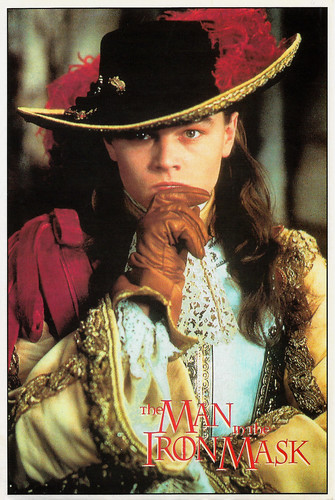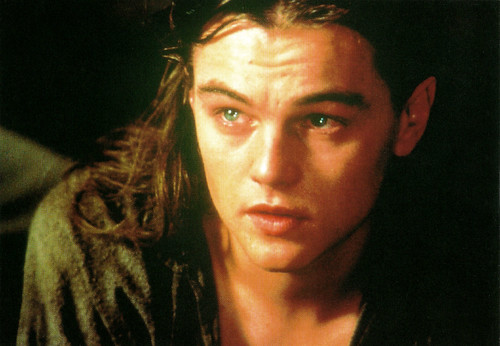Leonardo DiCaprio played a double role as the title character and the villain in The Man in the Iron Mask (Randall Wallace, 1998). The picture uses characters from Alexandre Dumas's Musketeers novels with Jeremy Irons as Aramis, John Malkovich as Athos, Gerard Depardieu as Porthos, and Gabriel Byrne as D'Artagnan. The film story is very loosely adapted from some plot elements of the novel 'The Vicomte de Bragelonne', the epilogue of the Musketeers novels. Gérard Depardieu was nominated for the European Film Academy Achievement in World Cinema Award for his role as Porthos. DiCaprio won a Golden Raspberry Award for Worst Screen Couple for his interactions as twins in the film.

French postcard by Sonis, no. C. 853. Photo: United Artists. Gérard Depardieu and Jeremy Irons in The Man in the Iron Mask (Randall Wallace, 1998).

French postcard by Sonis, no. C. 854. Photo: United Artists. Gabriel Byrne, Leonardo DiCaprio, John Malkovich, Gérard Depardieu, and Jeremy Irons in The Man in the Iron Mask (Randall Wallace, 1998).

French postcard by Sonis, no. C 856. Photo: United Artists. Leonardo DiCaprio, Gérard Depardieu, Jeremy Irons, and John Malkovich in The Man in the Iron Mask (Randall Wallace, 1998).
The Man in the Iron Mask (Randall Wallace, 1998) centers on the aging four musketeers, Athos, Porthos, Aramis, and D'Artagnan, during the reign of King Louis XIV and attempts to explain the mystery of the Man in the Iron Mask.
This man is a secret twin brother to the cruel King Louis XIV of France. While Paris is starving, the King is more interested in money and bedding women. When a young soldier dies for the sake of a shag, Aramis, Athos, and Porthos band together with a plan to replace the king by his twin who was hidden at birth, then imprisoned for years behind an iron mask.
All that remains now is D'Artagnan, will he stand against his long time friends, or do what is best for his country?
This plot is less related to the original Dumas book than to the flamboyant film version starring Douglas Fairbanks, The Iron Mask (Alan Dwan, 1929), and the version directed by James Whale, The Man in the Iron Mask (James Whale, 1939) with Louis Hayward. Like the 1998 version, these two adaptations were also released through United Artists.

British postcard by London Postcard Company, no. MG 2001. Photo: United Artists. Gérard Depardieu, Jeremy Irons, John Malkovich, Gabriel Byrne, and Leonardo DiCaprio in The Man in the Iron Mask (Randall Wallace, 1998).

British postcard by the London Postcard Company, no. MG 2004 (Series 1 of 9), Portrait #2. Photo: United Artists. Leonardo DiCaprio in The Man in the Iron Mask (Randall Wallace, 1998).

British postcard by the London Postcard Company, no. MG 2004 (Series 1 of 9), Portrait #3. Photo: United Artists. Leonardo DiCaprio as King Louis in The Man in the Iron Mask (Randall Wallace, 1998).

British postcard by the London Postcard Company, no. MG 2004 (Series 1 of 9), Portrait #6. Photo: United Artists. Leonardo DiCaprio as Phillippe in The Man in the Iron Mask (Randall Wallace, 1998).
The novel and the filmed versions of the tale have some differences in how they portray the royal twins and the plot to switch them. In the 1929 silent version, The Iron Mask starring Douglas Fairbanks as D'Artagnan, the King is depicted favourably and the twin brother as a pawn in an evil plot whose thwarting by D'Artagnan and his companions seems more appropriate.
In the 1998 film, the King is depicted negatively while his twin brother is sympathetically portrayed. D'Artagnan's loyalties are torn between his King and his three Musketeer friends. He is also revealed as the father of the twins, as well as being dedicated to the interests of France.
Many historical persons and events depicted in the film are heavily fictionalised, as declared in an opening narration. Louis XV was the great-grandson and successor of Louis XIV. He was born in 1710, and the events of the film take place about half a century before his birth.
D'Artagnan's death in the film is also inconsistent with biographic fact. The character is based on Charles de Batz-Castelmore d'Artagnan, a captain of the Musketeers of the Guard, who was killed in battle during the Siege of Maastricht (1673) - an event that concludes the Dumas novels, in which D'Artagnan is killed while reading the long-awaited notice of his promotion to the supreme command.
Louis XIV had a real-life brother, Philippe I, Duke of Orléans, who is not depicted in the film and was not the King's twin. Set in 1662, the film portrays the king as unmarried. The historical Louis XIV married his first wife Maria Theresa of Spain in 1660. They remained married until her death in 1683. Notwithstanding the peace and prosperity alluded to at the film's conclusion, Louis XIV spent most of the remainder of his reign at war.

British postcard by Boomerang Media. Photo: United Artists. Jeremy Irons in The Man in the Iron Mask (Randall Wallace, 1998).

Dutch postcard by Film Freak Productions Ltd., Zoetermeer, no. FA 466. Photo: United Artists. Leonardo DiCaprio and Anne Parillaud in The Man in the Iron Mask (Randall Wallace, 1998)

Dutch postcard by Film Freak Productions Ltd., Zoetermeer, no. FA 467. Photo: United Artists. Leonardo DiCaprio as Phillippe in The Man in the Iron Mask (Randall Wallace, 1998).

American postcard by Classico San Francisco, no. 105-641. Photo: United Artists. Leonardo DiCaprio and Jeremy Irons in The Man in the Iron Mask (Randall Wallace, 1998).
Sources: Wikipedia and IMDb.

French postcard by Sonis, no. C. 853. Photo: United Artists. Gérard Depardieu and Jeremy Irons in The Man in the Iron Mask (Randall Wallace, 1998).

French postcard by Sonis, no. C. 854. Photo: United Artists. Gabriel Byrne, Leonardo DiCaprio, John Malkovich, Gérard Depardieu, and Jeremy Irons in The Man in the Iron Mask (Randall Wallace, 1998).

French postcard by Sonis, no. C 856. Photo: United Artists. Leonardo DiCaprio, Gérard Depardieu, Jeremy Irons, and John Malkovich in The Man in the Iron Mask (Randall Wallace, 1998).
Will D'Artagnan stand against his long time friends?
The Man in the Iron Mask (Randall Wallace, 1998) centers on the aging four musketeers, Athos, Porthos, Aramis, and D'Artagnan, during the reign of King Louis XIV and attempts to explain the mystery of the Man in the Iron Mask.
This man is a secret twin brother to the cruel King Louis XIV of France. While Paris is starving, the King is more interested in money and bedding women. When a young soldier dies for the sake of a shag, Aramis, Athos, and Porthos band together with a plan to replace the king by his twin who was hidden at birth, then imprisoned for years behind an iron mask.
All that remains now is D'Artagnan, will he stand against his long time friends, or do what is best for his country?
This plot is less related to the original Dumas book than to the flamboyant film version starring Douglas Fairbanks, The Iron Mask (Alan Dwan, 1929), and the version directed by James Whale, The Man in the Iron Mask (James Whale, 1939) with Louis Hayward. Like the 1998 version, these two adaptations were also released through United Artists.

British postcard by London Postcard Company, no. MG 2001. Photo: United Artists. Gérard Depardieu, Jeremy Irons, John Malkovich, Gabriel Byrne, and Leonardo DiCaprio in The Man in the Iron Mask (Randall Wallace, 1998).

British postcard by the London Postcard Company, no. MG 2004 (Series 1 of 9), Portrait #2. Photo: United Artists. Leonardo DiCaprio in The Man in the Iron Mask (Randall Wallace, 1998).

British postcard by the London Postcard Company, no. MG 2004 (Series 1 of 9), Portrait #3. Photo: United Artists. Leonardo DiCaprio as King Louis in The Man in the Iron Mask (Randall Wallace, 1998).

British postcard by the London Postcard Company, no. MG 2004 (Series 1 of 9), Portrait #6. Photo: United Artists. Leonardo DiCaprio as Phillippe in The Man in the Iron Mask (Randall Wallace, 1998).
Many persons and events are heavily fictionalised
The novel and the filmed versions of the tale have some differences in how they portray the royal twins and the plot to switch them. In the 1929 silent version, The Iron Mask starring Douglas Fairbanks as D'Artagnan, the King is depicted favourably and the twin brother as a pawn in an evil plot whose thwarting by D'Artagnan and his companions seems more appropriate.
In the 1998 film, the King is depicted negatively while his twin brother is sympathetically portrayed. D'Artagnan's loyalties are torn between his King and his three Musketeer friends. He is also revealed as the father of the twins, as well as being dedicated to the interests of France.
Many historical persons and events depicted in the film are heavily fictionalised, as declared in an opening narration. Louis XV was the great-grandson and successor of Louis XIV. He was born in 1710, and the events of the film take place about half a century before his birth.
D'Artagnan's death in the film is also inconsistent with biographic fact. The character is based on Charles de Batz-Castelmore d'Artagnan, a captain of the Musketeers of the Guard, who was killed in battle during the Siege of Maastricht (1673) - an event that concludes the Dumas novels, in which D'Artagnan is killed while reading the long-awaited notice of his promotion to the supreme command.
Louis XIV had a real-life brother, Philippe I, Duke of Orléans, who is not depicted in the film and was not the King's twin. Set in 1662, the film portrays the king as unmarried. The historical Louis XIV married his first wife Maria Theresa of Spain in 1660. They remained married until her death in 1683. Notwithstanding the peace and prosperity alluded to at the film's conclusion, Louis XIV spent most of the remainder of his reign at war.

British postcard by Boomerang Media. Photo: United Artists. Jeremy Irons in The Man in the Iron Mask (Randall Wallace, 1998).

Dutch postcard by Film Freak Productions Ltd., Zoetermeer, no. FA 466. Photo: United Artists. Leonardo DiCaprio and Anne Parillaud in The Man in the Iron Mask (Randall Wallace, 1998)

Dutch postcard by Film Freak Productions Ltd., Zoetermeer, no. FA 467. Photo: United Artists. Leonardo DiCaprio as Phillippe in The Man in the Iron Mask (Randall Wallace, 1998).

American postcard by Classico San Francisco, no. 105-641. Photo: United Artists. Leonardo DiCaprio and Jeremy Irons in The Man in the Iron Mask (Randall Wallace, 1998).
Sources: Wikipedia and IMDb.
No comments:
Post a Comment